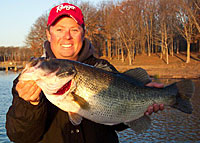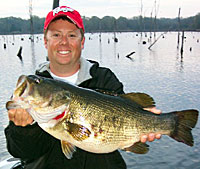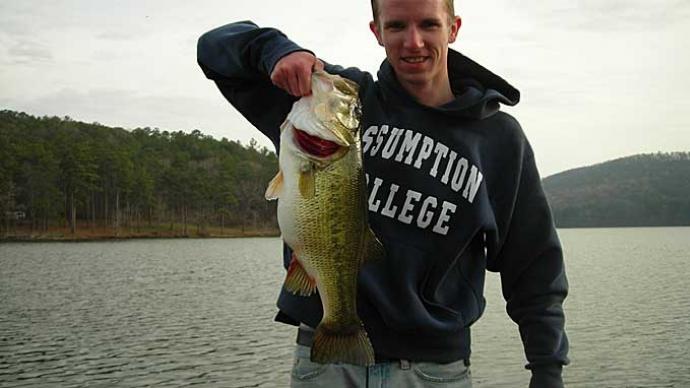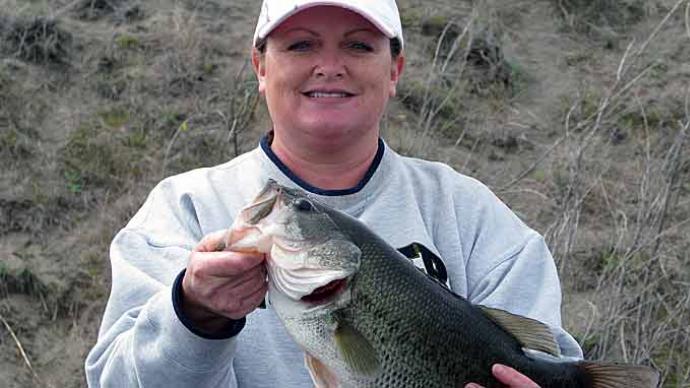
Historically, April is a month when many of the bass spawn on Lake Fork. Sight fishing is sometimes the most effective way to catch numbers of big bass, especially when the winds are light and a big wave of females move onto beds. However, I'm often asked if good bass can still be caught by techniques other than sight fishing in April. Take heart for those who don't care for sight fishing, have trouble seeing bass on beds, or face windy and cloudy conditions. Following are three patterns for catching springtime bass without sight fishing-muddy water, deeper water, and windy flats-and these techniques produce some of Fork's largest bass each year.
If water temps are in the 60s or warmer, muddy water is typically the first area I will try, especially if it is sunny and calm. Bass will be spawning in these areas but are often overlooked because sight fishermen cannot see them. Perpetually muddy areas have the muddiest water, typically the upper ends of the lake and the very back ends of the largest creeks. In addition, banks that receive the brunt of strong winds for several days or the backs of creeks after big rains are two locations in typically clearer areas that can also contain muddy water.
Catching spring bass in muddy water is usually pretty simple. Bass will be holding shallow, especially around hardcover like stumps, laydowns, and docks. Shallow submerged and emergent vegetation will also hold them, with holes in the grass being the key areas. Even the tiniest of sticks often holds a big fish, and bass typically won't move far to chase a bait, so fish thoroughly by making repeated casts to every piece of cover near the bank. I pitch black neon or blue bruiser colored Lake Fork Tackle Flippers or Top Dog lizards with a ¼ oz tungsten sinker, and Texas rigged on 65 lb braid. Usually, you'll only feel a little pressure or see your line move off on bigger fish. Let her have it if your bait feels any lighter or heavier than ¼ oz!
While shallow fishing works well in muddy water, fishing slightly deeper works best for lunkers in clearer water. In most areas of Fork, it's hard to see bass on beds in water deeper than 4' to 6'. Fishing slightly deeper in the 6' to 12' zone, approximately two casts off the shoreline in most areas, will give you access to large unpressured bass. Many females stage in slightly deeper water before spawning in 2' to 4', and I've seen bass on beds as deep as 10' on Fork; therefore, 6' to 12' is the magic depth in most areas. Premier structures in the 6' to 12' depth range include creek channels running through spawning flats, ledges along the edge of flats, and points near the mouth of spawning flats.
A lightweight Carolina rig, with an 18" leader and a ¼ to 3/8 oz weight on 20 lb Fluorocarbon line, is an excellent option for these bass. Tip your Carolina rig with a green pumpkin or watermelon-colored Top Dog Lizard, Baby Creature, or Magic Shad, and you'll be set. A 3/8 oz Mega Weight jig in green pumpkin/black or watermelon with a matching Fork Craw will produce real toads for thick grass and heavy timber areas. I suggest you step up to 50 or 65 lb braid with the jig, or you may get your heart broken.

Finally, shallow spawning flats in clear water can produce fantastic fishing on windy and overcast days. Big bass that are shy of boats in shallow water will often hold tight to their beds while spawning or feed actively before and after spawning on the nastiest of days. Big shallow flats with lots of grass are my favorite areas. For late prespawn and spawning fish, soft plastic jerkbaits are my top option. Magic Shads, Live Magic Shads, and Ring Frys rigged weightless Texas-style and dead-sticked are deadly. If the bass are shy of these bigger baits, a wacky rigged Twitch Worm will produce when nothing else works.
The low visibility and sinking characteristics of fluorocarbon make it the ideal line for these lures. I use a 20 lb fluorocarbon line for soft plastic jerkbaits and 15 lb test for wacky worming. Meanwhile, fishing for post-spawn fry guarding males and actively feeding females make for some great numbers days in later April on windblown flats. Cover lots of water with popper-style topwaters and floating jerkbaits in shad or chrome color schemes for these bass. To help keep these baits up high and muscle fish out of the brush and grass, use an abrasion-resistant fluorocarbon line such as Seaguar AbrazX.
If sight fishing isn't your strength, give muddy water, deeper water, or windy flats a try, and you'll catch lots of big bass in April. Here's hoping you catch the lunker of your dreams.




